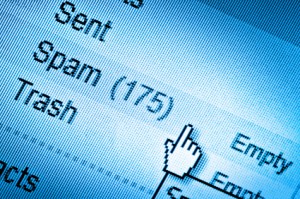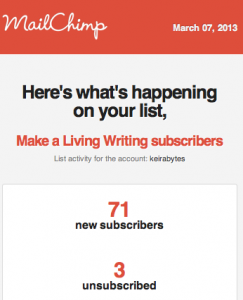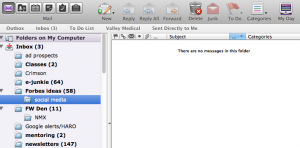
(You: “Hi Carol!”)
Here is the story of how email overwhelm nearly ruined both my freelance writing and personal lives, and how I slayed the email dragon and returned to sanity.
I’ve been writing since the days when email first began. And I loved it, right away.
It was so fun to come in, click that little ‘send and receive’ button, and get messages from people all over the world!
Until one day, it wasn’t so much fun anymore.
Drowning in email
I always got a decent volume of email. As a reporter, I subscribe to a lot of newsletters and like to read widely to look for sources and story ideas.
As my freelance career grew, I had more and better-quality clients. I felt the need to read even more widely to be on top of all their topics.
With my reputation on the rise and my visibility growing online, tastier leads would pop in on email. I needed to check frequently in case I missed a great opportunity!
In 2008, I started this blog. In 2010, I got on Twitter. And in 2011, I launched a membership community for writers.
Each of these additions brought more email — from blog subscribers and community members. I felt obligated to be “on top” of these emails and be responsive to my readers and paying community members.
But things quickly got out of control. My day often looked like this:
- 8-9 am. Arrive at office. Pick up email and watch as 150 new messages load up. Spend 90 minutes to 2 hours responding.
- 10:30 am. Get to end of emails and decide to check one last time for email. Get 50 more emails.
- 12 pm. Time for lunch.
- 1 pm. Respond to more emails.
- 2 pm. Start to panic as I realize I am getting nothing researched or written.
- 3 pm. Kids arrive home from school. Cry softly, as productive writing time is gone.
- 8 pm. Kids have gone to bed. I return to email. 40 more messages. Husband: “Could we watch Walking Dead now, honey?” “In a bit, I’ve got to answer these emails first, and I need to just write this one blog post I couldn’t get to today…”
- 11 pm. Husband gives up and goes to sleep.
Email was killing my productivity like a deranged maniac in a horror movie. It wasn’t so great for my relationships, either.
Clearly, this had to stop. But how?
Over the past few months, I’ve taken some drastic steps to cut my email time. Now, I’m down to perhaps an hour a day, and don’t feel the need to check it more than perhaps three times a day.
Below are the steps I took to get my email back under control. Buckle up — this process took months, and this is a lengthy post.
1. Analysis
First off, I set out to study my email. How much was there a day? What types of messages did I get? When did they arrive?
How urgent were they, really?
In looking critically at my email over several weeks, I came to a few quick conclusions:
- Most of my emails arrive before 10 a.m. The rest of the day, email volume is low.
- Total messages per day were often north of 200.
- Emails rarely contain truly urgent information.
- I get a lot of junk or low-value email.
Armed with these insights, I began to take action. My first area of focus was to kill email at its source.
2. Unsubscribe
My first course of action was to begin taking the time to unsubscribe to every newsletter I received that was no longer of interest.
Over the years, my beats have changed. But I was still getting news on dozens of niches I’m not currently covering — healthcare, real estate, technology, and more.
I took a week and unsubscribed like mad. I replied to PR pitches and asked the agency to take me off their list.
The result was amazing. Immediately, my volume of email shrank by about 40 percent.
This only made me hungry for more. What else could I do to reduce the amount of incoming mail?
3. Unsubscribe (the social media edition)
Besides news emails, I was receiving a ton of social-media notices. Each LinkedIn group I belonged to was sending an email each day. Facebook would hit me every time someone replied to a comment I left. Each tweet was also an email.

Think daily or weekly digests instead of per-action updates
Then there was the blog and community side. I got a notice every time someone unsubscribed to my blog, or lost their password for the community platform.
This was the second wave of wasted time. These notices were unnecessary because I ended up visiting my social sites usually at least once a day anyway! And on the blog/community side, I didn’t really need to monitor all these stats
It was a little time-consuming and tiresome to go onto each platform and learn how to turn off notifications. But once I did, the effect was incredible. I could get 10 emails from Mailchimp a day before. Now, I get one daily digest of activity on my blog email list. Magic!
Not only did I spend less time on email, but each social notice tempted me to go waste time on social media. Without them, I could turn my attention to my own agenda.
4. Declare email bankruptcy
I tend to be a string-gatherer in my quest for good blog-post ideas and story ideas for my freelance clients. There are dozens of newsletters I do still want to sift through. And they do pile up in my Newsletters email folder.
Then I’d feel obligated to read them. I’d feel like I couldn’t kick back for the night, because those newsletters were calling me!
Particularly when it came to my blog, I was obsessed with learning more about how to improve it. So I’d read and read.
This came to a head when I went on vacation in December with a goal of reading 160 accumulated newsletters while I was on vacation.
Obviously, that’s not much of a vacation.
So I did something else instead. I’d heard about celebrities and tech CEOs doing this when they got overwhelmed with email, so I gave it a try.
I simply deleted the whole file. All 160 messages. Buh-bye.
Then I went and spent the day walking around L.A. Farmer’s Market instead, enjoying window shopping in the winter sunshine.
Immediately, it was like a 100-pound weight was lifted from my shoulders.
There’s always more we can learn…but we can only learn so much. Sometimes, we have to do our work. And sometimes, we need to relax.
Once I got OK with killing off newsletters I’d saved, I wanted to take it up another level. Why was I saving so many newsletters I’d never have time to read?
5. Take the subject-line test
I used to feel an obligation to open a lot of my emails and read a bit before deciding whether to delete. No more.
Now, I read the subject line, and if I suspect it’s something I don’t need to read, I delete it right then.
We all have favorite blogs we read, but if they post daily, I realized, I don’t necessarily need to read every post they put up.
I used to save emails automatically because they were from X blog or newsletter. Now, I read the subject, and try to be realistic about whether this is a current topic of interest. If it’s not something I need to learn about or plan to write about in the short term — zap! — it’s gone.
6. Delete the ‘rules’
One thing I’d had recommended to me a while back was to have email folders and then set up rules that would automatically route email to the appropriate folder.
This is supposed to save you time, but in my case it wasted even more time.
The theory is that with this system, only important emails would show up in my main inbox, and I could put off looking at the other emails until later.
Except that I couldn’t. I’d chase around through nearly a dozen folders, trying to see where new emails had gone! Were they something time-critical that had accidentally gone the wrong place?
To fix this, I’ve turned off all email rules. All emails come initially into my main inbox.
I look through, and if there is something I want to save in a folder for future reading, I file it there, just like I used to do when I was a secretary. This gave me the confidence that I knew where things were and they were safely put away where they’d be useful later.
When it’s time to do my blog for Forbes, for instance, I go to that folder and presto — there are all the leads I have about franchising and entrepreneurship, the theme of my blog for them.
7. Don’t double-read
I often couldn’t resist the urge to read a bit of each incoming email, even if the message was clearly meant for a project or topic I knew I wouldn’t write about for days or even weeks yet.
Then, when it was time to deal with that topic, I’d end up having to read it again. By that time, I’d forgotten what it was about!
Killing this habit saved another chunk of time. Now, if the subject line tells me it’s for a subject that’s not on my schedule today, I throw it in the appropriate folder unread and don’t open it until that client is on the agenda.
8. Kill without reading
I used to feel obligated to open and read a bit of an email before deciding whether to delete it. This habit also had to go.
Now, I read the subject line, and if it doesn’t seem vital to any aspect of my freelance or blogging life, I delete it unopened.
This freaked me out at first, but now it’s become routine. I think of these like marketing calls you get on the phone — just hang up. Just because they emailed me doesn’t mean I have to devote time to their message.
9. Switch to ‘unread only’ mode
Looking at hundreds of emails sitting in my inbox always made me feel behind. Don’t these need to be dealt with?
I’ve solved this by putting all my folders into ‘unread only’ view.
Now, if I have responded to or read an email, it ‘disappears’ from view.
It’s still around in case I need to search it up again, but I don’t have to look at it sitting there. This makes me feel ‘done’ with email and ready to return to other tasks.
10. Strive for ‘inbox zero’

Bliss = “There are no unread messages in this folder.”
Inbox Zero is a concept created by entrepreneur Merlin Mann. The idea is that we should clear our inboxes each day.
Otherwise, the accumulation of email nags at us and makes us feel we have unfinished tasks on email.
I began to strive for this. When I review a batch of email, I want to either delete, file, or respond to each message. This ‘clean plate’ approach is very liberating.
I feel done! And ready to move on to another task.
I don’t always get all the way there — as I speak I have an unread item or two in my inbox — but it’s good to try.
11. Pick up in large batches
There’s a basic productivity issue with picking up email constantly — it’s inefficient. Each time we stop to deal with email, our focus goes away from an important task of writing or conceptualizing articles or blog posts or doing marketing or creating courseware.
I used to pick up email frequently. OK, really frequently. Really, really frequently.
Doing my data analysis and looking at how email wasted my time, I saw this was a big mistake.
I started to lengthen out the time between checks.
Now, if I pick up and there are fewer than 10 emails, I’m mad at myself. I’d prefer to deal with 30 or more at a time — it’s way more efficient.
With my data on when emails arrive, I came up with an email schedule that works for me.
I pick up once at 8 or 9 am, which catches the bulk of my email. Using all the techniques above, it now takes me perhaps a half-hour to process my email, at most.
I might check again mid-morning if it seems like a busy day.
From there, I really only need to check once or twice more in the day. I might check while I’m eating lunch, or at the end of the work day, or once in the evening. My data showed me few emails arrive in the afternoon, so now I’m confident I’m not missing a lot if I skip it.
This has cleared the afternoon as a block of newly discovered productive writing time.
12. Send less email and use EOM
Here’s a basic fact of email: Sending email tends to generate more emails in response. I started asking myself if I really needed to reply or if I could let a conversation end — or never start.
This is particularly true of spammy offers you get and other junk mailers. You might want to give them a piece of your mind, but it’s a waste of time. If you send less email, you get less email.
I also learned to write subject-line-only emails that close with (EOM) for end of message. As in, “I’m ready for our call now (EOM).”
This means there is nothing further to the email, it’s all in the subject line. So you can move on or delete after you read that line. I’ve trained my Den staff to use this, and it’s handy to cut a bit more time opening and reading emails.
The next step
I am far from done reducing my email clutter. I have yet to try any of the nifty new email-management tools out there.
One I’m intrigued by is The Swizzle — it helps you quickly unsubscribe from more emails, and turns all your remaining emails into one daily digest. Note: The Swizzle is no longer functioning.
There are many more tools out there to explore. I’m a pretty low-tech person, so initially I’ve focused on killing email at the source and being smarter in how I manage the remaining messages…but there are many approaches to take.
So far, I’d say I’ve probably liberated four hours or more a week for writing with the email-management changes I’ve made. I’m excited to see if I can reclaim even more time in the future as I keep refining my email routine.
How do you keep email time down? Leave a comment and share your strategies.









